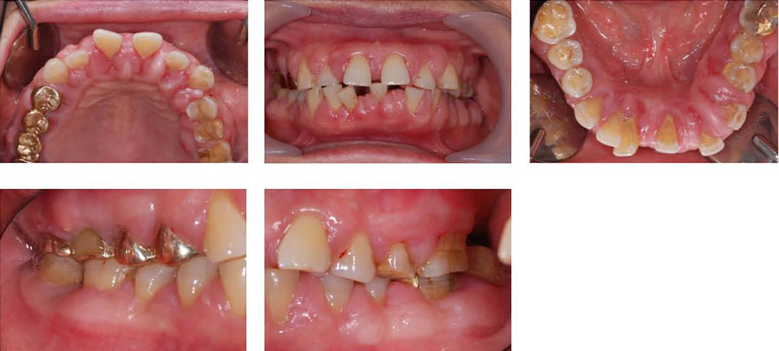J Korean Acad Periodontol.
2009 Mar;39(1):103-108. 10.5051/jkape.2009.39.1.103.
The effect of non-surgical treatment in gingival enlargement
- Affiliations
-
- 1Department of Periodontology, School of Dentistry, Kangnung National University, Korea. dentist@kangnung.ac.kr
- KMID: 1783522
- DOI: http://doi.org/10.5051/jkape.2009.39.1.103
Abstract
-
PURPOSE: It is well recognized that gingival enlargement is induced by unwanted effect associated with three major drugs/drug groups - phenytoin, cyclosporine, and the calcium channel blockers. The present case report describes the effect and limitation of non-surgical treatment in gingival enlargement cases.
MATERIALS AND METHODS
Three cases included 2 drug-influenced gingival enlargement patients and a idiopathic gingival fibromatosis patient. For the drug-influenced gingival enlargement patients, the medication was replaced with other medication. And then, all the patients were treated non-surgically.
RESULTS
Drug-influenced gingival enlargements had been reduced after non-surgical treatment and the results were well-maintained. In the idiopathic gingival fibromatosis case, non-surgical treatment resulted in only limited reduction of gingival enlargement, and surgical periodontal treatment was unavoidable.
CONCLUSION
These case reports indicated that non-surgical periodontal treatment with change in medication was effective in the treatment of drug-influenced gingival enlargements. Non-surgical approach can be considered as the primary management to reduce the gingival enlargement. If non-surgical treatment encounters a limitation, surgical treatment should be considered
MeSH Terms
Figure
Reference
-
1. Newman MG, Takei HH, Klokkevold PR, Carranza FA. Carranza's Clinical Periodontology. 2006. 10th ed. Philadelphia: W.B. Saunders;373–390.2. Rees TD, Levine RA. Systemic drugs as a risk factor for periodontal disease initiation and progression. Compend Contin Educ Dent. 1995. 16:20–42.3. Lewis IK, Hanlon JT, Schmader KE, et al. Use of medications with potential oral adverse drug interactions in community-dwelling elderly. Spec Care Dentist. 1993. 13:171–176.
Article4. Academy report: Drug-associated gingival enlargement. J Periodontol. 2004. 75:1424–1431.5. Kim WK, Baek J, Lee YK. The effect of periodontal therapy on the gingival thickness in patients with drug-induced gingival enlargement. J Korean Acad Periodontol. 2005. 35(4):1109–1116.
Article6. Casetta I, Granieri E, Desidera M, et al. Phenytoin-induced gingival overgrowth: A community-based cross-sectional study in Ferrara, Italy. Neuroepidemiology. 1997. 16:296–303.
Article7. Boltchi FE, Rees TD, Iacopino AM. Cyclosporine A-induced gingival overgrowth: A comprehensie review. Quintessence Int. 1999. 30:775–783.8. Barak S, Engelberg I, Hiss Z. Gingival hyperplasia caused by nifedipine: Histopathological findings. J Periodontol. 1987. 58:639–642.9. Nakou M, Kamma JJ, Andronikaki A, Mitsis F. Subgingival microflora associated with nifedipine-induced gingival overgrowth. J Periodontol. 1998. 69:664–669.
Article10. Fu E, Nieh S, Wikesjo UM. The effect of plaque retention on cyclosprine-induced gingival overgrowth in rats. J Periodontol. 1997. 68:92–98.
Article11. Mavrogiannis M, Ellis JS, Thomason JM, Seymour RA. The management of drug-induced gingival overgrowth. J Clin Periodontol. 2006. 33:433–439.
Article12. Somacarrera ML, Lucas M, Scully C, et al. Effectiveness of periodontal treatments on cyclosporine-induced gingival overgrowth in transplant patients. British Dental Journal. 1997. 183:89–94.
Article13. Aimetti M, Romano F, Marsico A, Navone R. Non-surgical periodontal treatment of cyclosporin A-induced gingival overgrowth: immunohistochemical results. Oral Dis. 2008. 14(3):244–250.
Article14. Seymour RA, Smith DG. The effect of a plaque control programme on the incidence and severity of cyclosporin-induced gingival changes. J Clin Periodontol. 1991. 18:107–110.
Article15. Hancock RH, Swan RH. Nifedipine-induced gingival overgrowth. J Clin Periodontol. 1992. 19:12–14.
Article16. Ellis JS, Seymour Ra, Steele JG, et al. Prevalence of gingival overgrowth induced by calcium channel blockers: A community-based study. J Periodontol. 1999. 70:63–67.
Article
- Full Text Links
- Actions
-
Cited
- CITED
-
- Close
- Share
- Similar articles
-
- The etiology and possible molecular mechanisms underlying calcium channel blocker-induced gingival enlargement: a narrative review
- The effect of periodontal therapy on the gingival thickness in patients with drug-induced gingival enlargement
- Surgical Treatment of Phenytoin Induced Gingival Hyperplasia: A Report of Case
- Oral signs of acute leukemia for early detection
- Effect of azithromycin on gingival overgrowth of organic transplanted patients













